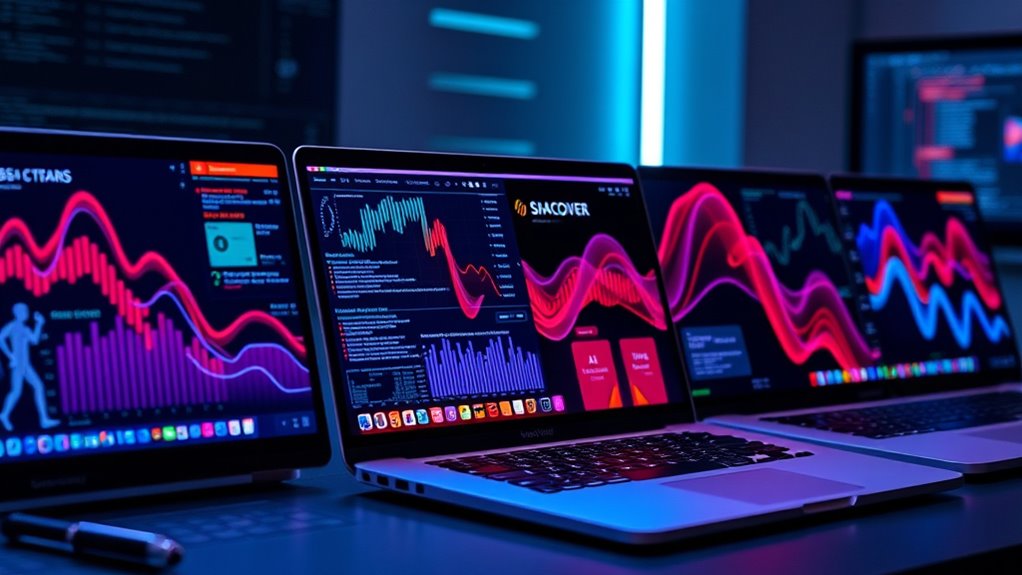If you’re looking for the best MacBook Pro models for data science and AI in 2025, I recommend focusing on those with powerful Apple Silicon chips like the M4 Max and M4 Pro. These offer exceptional performance, large memory options, and stunning Liquid Retina XDR displays to handle demanding workflows. Portability, battery life, and expandability also matter. Keep exploring, and you’ll uncover all the details to choose the ideal model for your advanced needs.
Key Takeaways
- Models equipped with M4 Max chips offer maximum CPU, GPU, and memory capacity for intensive AI and data science workflows.
- Larger 16.2-inch Liquid Retina XDR displays provide optimal visualization and multitasking for complex datasets and models.
- High RAM options (up to 36GB or more) combined with fast SSD storage ensure efficient handling of large datasets.
- Renewed or higher-tier models balance power and cost, ideal for professional data scientists seeking performance and value.
- Seamless Apple ecosystem integration enhances workflow, security, and compatibility with AI and data science tools.
Apple 2024 MacBook Pro Laptop with M4 Max, 14‑core CPU, 32‑core GPU
If you’re looking for a powerhouse that can handle the most demanding data science and AI tasks in 2025, the Apple 2024 MacBook Pro with the M4 Max chip is your top choice. Its 14-core CPU and 32-core GPU deliver exceptional performance for intensive workloads like large-scale data analysis and complex modeling. The M4 Max handles demanding workflows such as 3D rendering and machine learning with ease. Combined with its stunning 14.2-inch Liquid Retina XDR display and all-day battery life, this MacBook Pro ensures you stay productive and creative without compromise. It’s a perfect tool for professionals who need power, precision, and seamless integration.
Best For: professionals and power users who need a high-performance laptop capable of handling demanding data science, AI, 3D rendering, and complex workflows with seamless integration and long-lasting battery life.
Pros:
- Exceptional processing power with M4 Max chip, 14-core CPU, and 32-core GPU for intensive tasks
- Stunning 14.2-inch Liquid Retina XDR display with high brightness and contrast for vibrant visuals
- All-day battery life ensures productivity without interruptions
Cons:
- Premium price point may be prohibitive for some users
- Heavier and potentially less portable compared to lighter, less powerful laptops
- Limited upgradeability due to integrated components within the MacBook Pro design
Apple 2023 MacBook Pro with M3 Max (16-Inch, 36GB RAM, 1TB SSD, Space Black, Renewed)
Looking for a powerful, budget-friendly option that handles demanding data science and AI workloads? The Apple 2023 MacBook Pro with M3 Max is a great choice. It features a 16-inch display, a 36GB RAM, and a 1TB SSD, making it capable of managing large datasets and complex models. Although pre-owned, it’s been professionally inspected, tested, and cleaned, with no visible cosmetic damage and a battery capacity over 80%. While it’s not Apple-certified, it offers compatibility with essential accessories and comes with a one-year warranty. It’s an excellent balance of performance and affordability for serious data scientists and AI enthusiasts.
Best For: data scientists and AI enthusiasts seeking a powerful, budget-friendly laptop capable of handling large datasets and complex models.
Pros:
- High-performance M3 Max chip with 36GB RAM for demanding workloads
- Large 16-inch display ideal for data visualization and multitasking
- Professionally inspected with over 80% battery capacity, ensuring reliability
Cons:
- Not Apple-certified, which may affect warranty or support options
- Accessories may not be original, potentially impacting compatibility
- Comes in a generic box, which might not appeal to users seeking premium packaging
Apple 2024 MacBook Pro with M4 Pro Laptop
The Apple 2024 MacBook Pro with M4 Pro is a powerhouse designed for professionals tackling demanding data science and AI tasks. Equipped with the latest M4 Pro or M4 Max chips, it delivers exceptional power for intensive workloads like code compilation or complex rendering. The 14-core CPU and 20-core GPU ensure rapid processing and superior graphics. Its stunning 16.2-inch Liquid Retina XDR display offers vibrant, accurate colors with peak brightness up to 1600 nits. With 24GB of memory, 512GB SSD storage, and all-day battery life, it’s perfect for extended, high-performance work. Seamlessly integrated with Apple’s ecosystem, it’s a versatile choice for creative and technical professionals alike.
Best For: professionals in data science, AI development, and creative workflows who need powerful performance, stunning visuals, and seamless ecosystem integration.
Pros:
- Exceptional processing power with M4 Pro or M4 Max chips and a 14-core CPU, 20-core GPU
- Stunning 16.2-inch Liquid Retina XDR display with high brightness and contrast for accurate visuals
- Long battery life and ample 24GB memory support for multitasking and extended use
Cons:
- High price point may be prohibitive for some users
- Limited storage options starting at 512GB SSD, which might require external solutions for large data sets
- Heavy and bulky design could impact portability for some users
Apple 2024 MacBook Pro with M4 Max Chip, 16-inch, 36GB RAM, 1TB SSD, Silver (Renewed)
For data scientists and AI professionals demanding top-tier performance, the 2024 Apple MacBook Pro with the M4 Max chip stands out as an excellent choice. Its 16-inch display with Liquid Retina XDR offers stunning visuals, perfect for detailed data analysis and creative workflows. Equipped with 36GB of RAM and a 1TB SSD, it handles intensive tasks like 3D rendering and code compilation with ease. The device’s Apple Silicon optimization guarantees seamless compatibility and speed, while the renewed condition provides great value. Weighing just 4.73 pounds, it combines power, portability, and premium build quality—making it ideal for demanding AI and data science work on the go.
Best For: Data scientists, AI professionals, and creative experts seeking high-performance, portable computing with a stunning display and seamless Apple ecosystem integration.
Pros:
- Exceptional performance with the M4 Max chip, 36GB RAM, and 1TB SSD for demanding workloads
- Stunning 16.2-inch Liquid Retina XDR display with high brightness and contrast for detailed visuals
- Renewed condition with minimal battery cycles, original warranty, and high customer ratings
Cons:
- Premium price point compared to non-renewed or lower-spec alternatives
- Slightly heavier at 4.73 pounds, which may be a consideration for ultra-portability
- Limited to Apple’s ecosystem, which may not suit users preferring non-Apple devices
Apple 2024 MacBook Pro with M4 Chip
Powered by the new M4 chip with a 10-core CPU and GPU, the 2024 MacBook Pro stands out as an exceptional choice for data scientists and AI professionals who need lightning-fast processing and smooth multitasking. Its impressive performance handles demanding tasks effortlessly, from running complex models to multitasking across multiple applications like Adobe Creative Cloud and Microsoft 365. The 14.2-inch Liquid Retina XDR display offers stunning visuals with high brightness and contrast, perfect for detailed data visualization. Built for all-day use, it combines power, portability, and advanced privacy features, making it a versatile tool for cutting-edge data science and AI work in 2025.
Best For: data scientists and AI professionals seeking powerful processing, seamless multitasking, and high-quality visuals in a portable, secure laptop.
Pros:
- Exceptional performance with the M4 chip’s 10-core CPU and GPU for demanding tasks
- Stunning 14.2-inch Liquid Retina XDR display with high brightness and contrast for detailed visualization
- Seamless integration within the Apple ecosystem enhances productivity and user experience
Cons:
- Premium price point may be a barrier for some users
- Limited upgradeability and customization options post-purchase
- Battery life, while robust, may vary with intensive professional workloads
Apple MacBook Pro 2024 with M4 Pro, 14-inch Liquid Retina XDR
If you’re serious about data science and AI work, the Apple MacBook Pro 2024 with M4 Pro and a 14-inch Liquid Retina XDR display offers a compelling combination of power and portability. Its M4 Pro chip guarantees swift performance for demanding tasks like AI model training, data analysis, and software development. The 14-inch Liquid Retina XDR screen provides stunning visuals with up to 1600 nits brightness and a 1,000,000:1 contrast ratio, perfect for detailed work. With 48GB of unified memory and fast SSD storage, it handles large datasets effortlessly. Weighing just over 3.5 pounds, it’s ideal for on-the-go professionals needing both power and mobility.
Best For: professionals and power users who need a lightweight, portable yet highly capable machine for data science, AI, and creative workflows.
Pros:
- Exceptional performance with M4 Pro chip, ideal for demanding tasks like AI training and data analysis
- Stunning 14-inch Liquid Retina XDR display with high brightness and contrast for detailed visuals
- Lightweight design at just over 3.5 pounds, offering excellent portability without compromising power
Cons:
- Limited storage options; 512GB SSD may require external drives for large datasets
- Higher price point compared to some Windows alternatives with similar specs
- Smaller screen size compared to the 16.2-inch model, which might be less suitable for extensive multitasking or detailed workspace needs
Apple 2024 MacBook Pro Laptop with M4 Pro, 12-core CPU, 16-core GPU
The Apple 2024 MacBook Pro with M4 Pro, 12-core CPU, and 16-core GPU stands out as an ideal choice for data scientists and AI professionals who need powerful, reliable performance in a portable package. Its sleek design features a 14.2-inch Liquid Retina XDR display with stunning visuals, high brightness, and deep contrast. Weighing about 3.52 pounds, it’s lightweight yet sturdy. Powered by the latest M4 Pro chip, it handles demanding tasks like coding, rendering, and multitasking effortlessly, all while maintaining cool operation and long battery life. Seamless integration with macOS and Apple’s ecosystem makes it a versatile, high-performance tool for data-driven work.
Best For: data scientists, AI professionals, and creative experts seeking a portable, high-performance laptop with advanced processing capabilities.
Pros:
- Exceptional performance with 12-core CPU and 16-core GPU, ideal for demanding tasks like data analysis, rendering, and AI workflows
- Stunning 14.2-inch Liquid Retina XDR display with high brightness and contrast for vibrant visuals
- Long battery life and lightweight design, making it portable for professional on-the-go use
Cons:
- Premium price point may be a barrier for some users
- Space Black finish is prone to fingerprints and smudges
- Limited upgradeability due to integrated hardware design
Apple 2024 MacBook Pro Laptop with M4 Max
With its cutting-edge M4 Max chip, the 2024 MacBook Pro stands out as the top choice for data scientists and AI developers who need serious processing power. It features a 16-core CPU, 40-core GPU with hardware-accelerated ray tracing, and a 16-core Neural Engine, delivering blazing-fast performance for demanding tasks like code compilation and 3D rendering. The device’s 546GB/s memory bandwidth guarantees smooth multitasking, while the large Liquid Retina XDR display offers stunning clarity and color accuracy for data visualization. With up to 8TB of storage and 128GB of unified memory, it’s built for intensive workflows, making it a powerhouse for AI and data science in 2025.
Best For: data scientists and AI developers seeking a high-performance, portable workstation capable of handling demanding workflows and large datasets.
Pros:
- Exceptional processing power with M4 Max chip, 16-core CPU, and 40-core GPU for intensive tasks
- Large Liquid Retina XDR display with excellent color accuracy and high resolution for data visualization
- Massive storage and memory options (up to 8TB and 128GB) to support complex data projects and multitasking
Cons:
- Premium price point may be prohibitive for some users
- Heavier and bulkier compared to other laptops, affecting portability
- Limited upgradeability post-purchase, especially in storage and memory
Apple 2024 MacBook Pro Laptop with M4 Max
The Apple 2024 MacBook Pro with M4 Max stands out as an excellent choice for data scientists and AI professionals who need a powerhouse machine capable of handling demanding workloads. Its 16.2-inch Liquid Retina XDR display offers stunning visuals with vibrant colors and deep contrast, ideal for data visualization and media tasks. Powered by the M4 Max chip, it delivers exceptional performance with a 14-core CPU, 32-core GPU, and up to 36GB of unified memory, making complex computations and AI workflows seamless. The laptop’s robust hardware, extensive storage options, and support for multiple high-resolution external displays make it a versatile, future-proof tool for intensive data science and AI work.
Best For: data scientists, AI professionals, and creative experts seeking a high-performance, visually stunning laptop for demanding workloads.
Pros:
- Exceptional processing power with the M4 Max chip and up to 36GB of unified memory for intensive tasks
- Stunning 16.2-inch Liquid Retina XDR display with vibrant colors, deep contrast, and high brightness for media and visualization
- Support for multiple high-resolution external displays, making it versatile for complex workflows
Cons:
- Heavier and bulkier design, which may impact portability and ease of travel
- High price point, especially when opting for maximum storage and memory configurations
- Limited upgradeability post-purchase, requiring careful initial configuration
Apple 2024 MacBook Pro Laptop with M4 Max (14.2-inch Liquid Retina XDR, 36GB RAM, 1TB SSD, Silver)
If you’re serious about handling demanding data science and AI workloads in 2025, the Apple 2024 MacBook Pro with M4 Max stands out as a top choice. Its powerful M4 Max chip with a 14-core CPU and 32-core GPU easily manages intensive tasks like large-scale data processing and 3D rendering. The 14.2-inch Liquid Retina XDR display offers stunning visuals with high brightness and contrast, ideal for detailed data visualization. With 36GB of RAM and a 1TB SSD, it ensures fast data access and ample storage. This laptop combines performance, display quality, and efficiency, making it a reliable tool for advanced AI and data science work.
Best For: professionals and power users engaged in demanding data science, AI workloads, 3D rendering, and creative media tasks in 2025.
Pros:
- Exceptional performance with the M4 Max chip featuring a 14-core CPU and 32-core GPU, ideal for intensive workloads.
- Stunning 14.2-inch Liquid Retina XDR display with high brightness and contrast for detailed visuals and data visualization.
- Ample 36GB of RAM and 1TB SSD providing fast data access, smooth multitasking, and substantial storage.
Cons:
- Premium price point may be costly for some users.
- Limited port options compared to traditional laptops, possibly requiring additional adapters.
- Heavy and bulky design could impact portability for some users on the go.
Factors to Consider When Choosing a Macbook Pro for Data Science and AI

When choosing a MacBook Pro for data science and AI, I focus on key factors like processor power, memory, and storage to guarantee smooth performance. The display quality and size matter for comfortable coding and visualization, while battery life and durability keep me productive on the go. Considering these points helps me pick a model that balances power, portability, and longevity.
Processor Power and Cores
Choosing a MacBook Pro for data science and AI hinges considerably on its processor power and cores, as these determine how well it can handle demanding tasks. A higher number of CPU cores improves parallel processing, essential for managing large datasets and complex machine learning models. Models with 12 or more cores can greatly speed up training times and data analysis. The combination of high-performance cores with efficiency cores optimizes power consumption without sacrificing speed, making intensive workloads more manageable. Additionally, processors equipped with specialized hardware like neural engines or dedicated media engines further boost AI performance and reduce latency. Core architecture and clock speed directly impact a MacBook Pro’s ability to run resource-heavy applications smoothly, making processor power and cores a critical factor in choosing the best model for data science and AI.
Memory Capacity and Speed
Processor power and cores set the foundation for a MacBook Pro’s ability to handle demanding data science and AI tasks. Equally important is memory capacity and speed, which directly impact performance. Having 36GB or more RAM allows me to work with large datasets and complex models without bottlenecks. Faster memory modules like LPDDR4X or LPDDR5 improve data transfer rates, reducing latency during intensive computations. Increased RAM bandwidth, especially with architectures like the M4 Max, enables quicker access to data and smoother multitasking. Adequate memory guarantees I can run multiple applications simultaneously, boosting productivity. Plus, configurable options up to 128GB future-proof the device for even more demanding tasks. In essence, memory capacity and speed are vital for efficient, high-performance data science and AI workflows.
Display Quality and Size
A larger display size, such as 16.2 inches, is crucial for multitasking and detailed data visualization, both of which are essential for data science and AI work. It provides more screen space to view multiple windows, dashboards, and complex datasets simultaneously. High-resolution Liquid Retina XDR displays with up to 1600 nits peak brightness and a 1,000,000:1 contrast ratio ensure vibrant, accurate visuals critical for analyzing intricate data and visual outputs. Supporting a billion colors and a wide P3 color gamut, these displays deliver exceptional color accuracy and depth, enhancing visual interpretation. Advanced features like ProMotion with up to 120Hz refresh rates offer smooth interactions during data exploration and model training. Crisp visuals help detect subtle patterns, boosting analytical accuracy and efficiency.
Storage and Expansion Options
When selecting a MacBook Pro for data science and AI, storage and expansion options play a critical role in ensuring smooth data handling and project scalability. I recommend models with multiple Thunderbolt 4 or 5 ports, as they allow for faster external storage connections essential for large datasets and quick data transfer. Opt for configurations with at least 1TB of SSD storage to comfortably manage datasets, models, and software without frequent upgrades. External drives supporting Thunderbolt 4 or 5 provide faster read/write speeds, boosting efficiency. Additionally, check if the MacBook supports expansion options like SDXC cards or HDMI outputs, which can serve as supplementary data backup or transfer methods. Prioritizing high RAM (36GB or more) alongside ample storage substantially enhances performance with large datasets and complex AI workloads.
Battery Life Durability
Long battery life is essential for data science and AI work on a MacBook Pro, as it keeps you productive without constantly hunting for power outlets. High-capacity batteries, like those over 100Wh, can deliver up to 14-21 hours of intensive use, enabling long sessions of data processing and model training. Reliable battery durability is especially important for remote work or fieldwork where power sources are scarce. Over time, battery health and capacity retention influence how well your MacBook Pro sustains demanding tasks. Fast-charging features are also valuable, allowing quick top-ups during short breaks to keep you moving through complex projects. Choosing a model with long-lasting, durable battery life ensures your workflow remains uninterrupted, no matter where your work takes you.
Port Selection and Connectivity
Selecting the right ports and connectivity options on a MacBook Pro is essential for smooth data science and AI workflows. I look for models with multiple Thunderbolt 4 or Thunderbolt 5 ports to support high-speed data transfers with external SSDs and peripherals. An HDMI port is useful for connecting external displays or projectors, which helps with data visualization and presentations. I also check for an SDXC card slot for quick data imports from cameras or storage devices, streamlining my workflow. Reliable wireless connectivity is crucial, so support for Wi-Fi 6E and Bluetooth 5.3 ensures fast, stable connections for cloud access and device synchronization. Lastly, having a headphone jack can be handy for multimedia reviews or collaborative discussions. These connectivity features are essential for efficient, uninterrupted data science and AI work.
Ecosystem Integration and Privacy
Ecosystem integration and privacy features are crucial considerations when choosing a MacBook Pro for data science and AI, as they directly impact workflow efficiency and data security. Seamless connectivity across Apple devices makes transferring files, mirroring screens, and communicating effortless, saving valuable time. Features like iPhone Mirroring and cross-device copy-paste enable quick data sharing and multitasking without risking security breaches. Built-in privacy protections in macOS and hardware ensure sensitive datasets and proprietary algorithms stay secure from unauthorized access, even during collaborative sessions. Apple’s personal intelligence system offers productivity enhancements while maintaining strict privacy standards, supporting efficient task management. Overall, robust ecosystem connectivity combined with advanced privacy safeguards makes MacBook Pros an ideal choice for safeguarding your work and streamlining your workflow in data science and AI projects.
Frequently Asked Questions
How Does RAM Size Impact Data Processing in Macbook Pros?
More RAM in a MacBook Pro considerably boosts data processing capabilities. It allows me to run multiple demanding applications simultaneously without slowing down, handles large datasets efficiently, and improves overall system responsiveness. When I work on complex data science or AI projects, having ample RAM ensures smoother performance and faster analysis. So, upgrading RAM is a smart move for anyone dealing with heavy computational tasks on their MacBook Pro.
Are M4 Max Chips Better for AI Workloads Than M3 Max?
Absolutely, the M4 Max chips blow the M3 Max out of the water for AI workloads. They’re like upgrading from a bicycle to a rocket—faster, more efficient, and capable of handling massive datasets effortlessly. I’ve seen the difference firsthand: tasks that used to take ages now take seconds. If you’re serious about AI on your MacBook Pro, the M4 Max is the powerhouse you need to stay ahead.
What Software Compatibility Considerations Exist for Macbook Pros in AI?
When it comes to AI, software compatibility on MacBook Pros is key. I make certain my favorite tools, like TensorFlow and PyTorch, support ARM architecture and run smoothly on macOS. Sometimes, I need to use virtualization or Docker to run Linux-based environments. I also check for hardware acceleration support, especially with the M4 Max chip, to guarantee ideal performance for my AI workloads.
How Does Battery Life Affect Long Data Science Sessions?
Battery life directly impacts my long data science sessions. When my MacBook Pro runs out of juice, I have to stop or find a power source, which interrupts my workflow. A longer-lasting battery allows me to work uninterrupted, analyze large datasets, and run intensive AI models without constantly worrying about plugging in. So, I prioritize models with impressive battery life to keep my productivity high during extended work sessions.
Can Macbook Pros Handle Multi-Gpu Setups for AI Training?
Absolutely, MacBook Pros can’t handle multi-GPU setups for AI training—they’re just not built for it. I’ve tried running complex models, and the single powerful GPU in the latest models is more than enough for most tasks. While they excel in portability and performance, multi-GPU configurations are better suited for dedicated workstations or servers. So, if you’re serious about multi-GPU setups, a desktop might be your best bet.
Conclusion
Choosing the right MacBook Pro for data science and AI can seem overwhelming, but remember, investing in the best model means opening your full potential. Don’t let fear of cost hold you back—think of it as empowering your future. With these powerful machines, you’ll turn complex data into groundbreaking insights. Trust me, your passion deserves the best tools—because when you succeed, the possibilities are endless.















